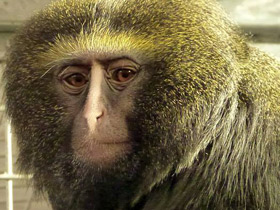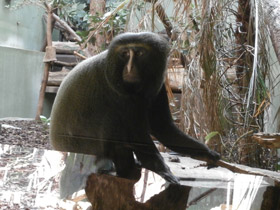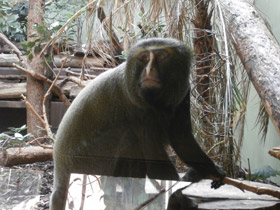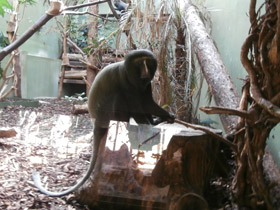The Hamlyn's monkey (Cercopithecus hamlyni), the owl-faced monkey
The Hamlyn's monkey (Cercopithecus hamlyni), also known as the owl-faced monkey, is a species of Old World monkey that inhabits the bamboo and primary rainforests of the Congo. This species is exceedingly rare and known only from a few specimens; little is known about it. However these specimens tend to be widely dispersed throughout the eastern part of Congo, from the Epulu River to the Lukuga River and from the Congo River to the Kabale Forest, with one example in northwestern Rwanda. Geographically it corresponds quite closely to another species of monkey, L'Hoest's monkey Cercopithecus lhoesti. It travels on the ground, and researchers think that it may be awake primarily by night.
Schwarz (1928) grouped this species with Cercopithecus l'hoesti, while Elliot (1913) noted its distinctive cusp pattern on the third molar, and reassigned it to a separate genus, Rhinostigma. This he believed to be an intermediate between Cercopithecus and Cercocebus. Hamlyn's monkey has one subspecies other than the nominate. In weight, the male is much larger than the female, with the average adult weighing 7 to 10 kg, while females weigh on average 4.5 to 6 kg. It is thought to be a frugivore-folivore in diet. Some published reports indicated that Hamlyn's monkey lives in small groups, of ten members or less, with one male and multiple females, with no data to show them occurring in monogamous groups. The species has been found only in higher elevations, above 900m and up to 4600m. In color it is generally dark gray, with a characteristic white stripe which extends from the root of the nose to the upper lip, giving it an owl-like appearance, hence the name "owl-faced monkey". The name "Hamlyn's monkey" and the scientific epithet "hamlyni" come from the animal dealer who first brought this species to the London Zoo. It has scent glands on its chest with which it marks its territory. Both sexes have bare, blue buttocks, and the mature male has bright red and blue genitals. The juvenile coloration is a yellow-brown coat and a pink face. In captivity it has been known to live for about 33 years. Like others of this genus, it covers a wide area in its daily travels, mostly in a search for food.
Subspecies
- Cercopithecus hamlyni hamlyni;
- Cercopithecus hamlyni kahuziensis.
Habitat
Cercopithecus hamlyni is a species of catarrhine primate in the family Cercopithecidae. Cercopithecus hamlyni is common on the African continent, where it is found in eastern Democratic Republic of Congo, northwestern Rwanda and extreme southwestern Uganda and Burundi. Its main habitat is dense tropical forests growing at altitudes of no less than 900 m above sea level; the monkeys can climb even higher, up to 3200 m.
Appearance
Cercopithecus hamlyni is a medium-sized monkey with a relatively short tail. Adult males are 50-65 cm long and females 40-55 cm, and weigh 4-10 kg (males weigh 7-10 kg and females 4.5-6 kg).
The face of these big-eyed primates is somewhat reminiscent of an owl. It is black in colour and has a horizontal stripe across the eyebrows and a vertical stripe running from the centre of the eyebrows to the lip area. These two stripes vary in colour from creamy yellow to almost white and form the characteristic tattoo marks on the face of these monkeys. Their long, olive-grey fur provides good camouflage against predators.
Nutrition
Cercopithecus hamlyni is a predominantly frugivorous primate, preferring fruits and flowers (50-60%), but also eats leaves (20-25%) and invertebrates (10-20%). Generally, these monkeys forage for insects (caterpillars, ants) and spiders in a slow and leisurely manner, searching under bark and straggling lichens.
Social behaviour and reproduction
Cercopithecus hamlyni lives in groups consisting of several females with their immature young and one male. As a rule, the number of members in a group does not exceed 10 individuals.
Sometimes several groups join together to form large conglomerates which may contain several sexually mature males each, but this does not usually last long.
Each group sticks to its feeding area, which the monkeys mark with their pectoral scent glands. The breeding season for Cercopithecus hamlyni is in May and October, and the female usually gives birth to a young with a two-year interval between births.




















































